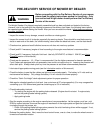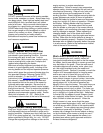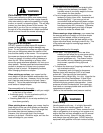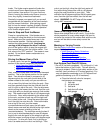
8
Zero-Radius Turn Operation
During zero-radius turns (when one mower wheel
rotates backwards while the other rotates forward)
drive extra slowly to reduce the possibility of losing
traction, or control, or becoming dizzy. This will help
prevent you from being thrown off the mower. Be
aware that if you do a turn on a slope you may go
through all of the orientations to a slope mentioned
below and must handle the mower accordingly.
Operation on Slopes
DO NOT operate on steep slopes 25 degrees or
greater for long periods or engine damage may
occur. Do not operate the mower on slopes steeper
than you can feel secure about the traction of the
tires and the stability of the mower. Do not operate
the mower on slopes at all when the grass is wet.
There is a danger of suddenly sliding sideways or
down the hill. When operating on a slope, travel
across the grade whenever possible, not in an up or
down pattern. Reduce speed and exercise extreme
caution on slopes and in sharp turns to prevent
tipping or loss of control. Be especially cautious
when changing direction on slopes.
When pointing up a slope, your mower has the
most weight on the drive wheels and therefore the
most traction at the tires. However, this is the angle
that it has the most tendency to tip back (“pop a
wheelie.”) This is the preferred angle for mowing
small areas of steeper slopes.
Recommendations for this angle:
• Lean as far forward as possible to add your weight
to the front of the mower.
• Accelerate gently. Do not accelerate quickly to
avoid “popping a wheelie”.
• If backing down the hill, do not stop suddenly but
slow down gradually.
When pointing down a slope, your mower has the
least weight on the rear drive wheels and therefore
the least traction at the tires. This is the angle that
the mower has the most tendency to slide.
However, this is the angle that it has the least
tendency to tip back. Avoid this angle, as it has the
least advantage for your mower.
Recommendations for this angle:
• Lean back with arms stretched out straight while
holding onto the stationary handlebar. This
transfers more of your body weight to the rear
drive wheels for more traction.
• Do not change speed suddenly to minimize the
tendency of going into a slide. Accelerate and
decelerate gently. If you ever go into an
uncontrolled slide while pointing down a slope
the recommended procedure is to let go of the
handles and jump off if necessary. Otherwise,
control the mower gently and stay off slopes
that tend to make the wheels slide.
When crossing a slope sideways, your mower has
the average amount of weight on the drive wheels
versus the front wheels, similar to level ground.
However, this angle leaves the least weight on the
higher side drive wheel, tending to make it slip. This
is the preferred angle for mowing large areas of
gentle slopes.
Recommendations for this angle:
• Lean back. This adds weight to the rear drive
wheels and will allow you to mow more quickly
across the slope without sliding. These are
general guidelines only. The mower function
and comfort will vary depending on mowing
environment, operator driving style and
preference.
• To reduce the chances of “popping-a-wheelie”, do
not accelerate quickly.
Note: Excessively worn tire tread is dangerous.
Replace tire(s) with less than 3/32” of any tread
groove left. Use tires with the tread pattern
recommended by Wright Mfg., Inc. only. Keep the tire
pressure in the drive tires between 18 and 22 psi.
Higher pressures will cause the tires to have less
traction which may prevent safe operation. Lower
pressure will affect the deck pitch, thus creating a
level deck or a reverse pitched deck and this WILL
compromise cut quality.
(Refer to tire maintenance and pressure section)
Fuel Safety
Handle gasoline with care – it is highly flammable.
Do not smoke while handling gasoline. Use an
approved gasoline container. Never remove the fuel
cap or add gasoline to a running or hot engine or an
engine that has not been allowed to cool for several
minutes after running. Never fill the tank indoors
and always clean up spilled gas. NEVER store the
equipment with gasoline in the tank inside a building
WARNING
WARNING
WARNING


















